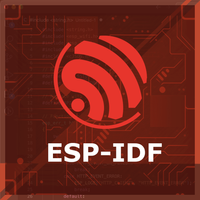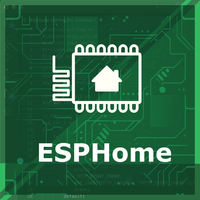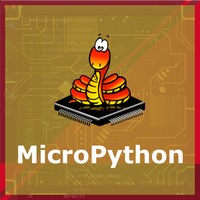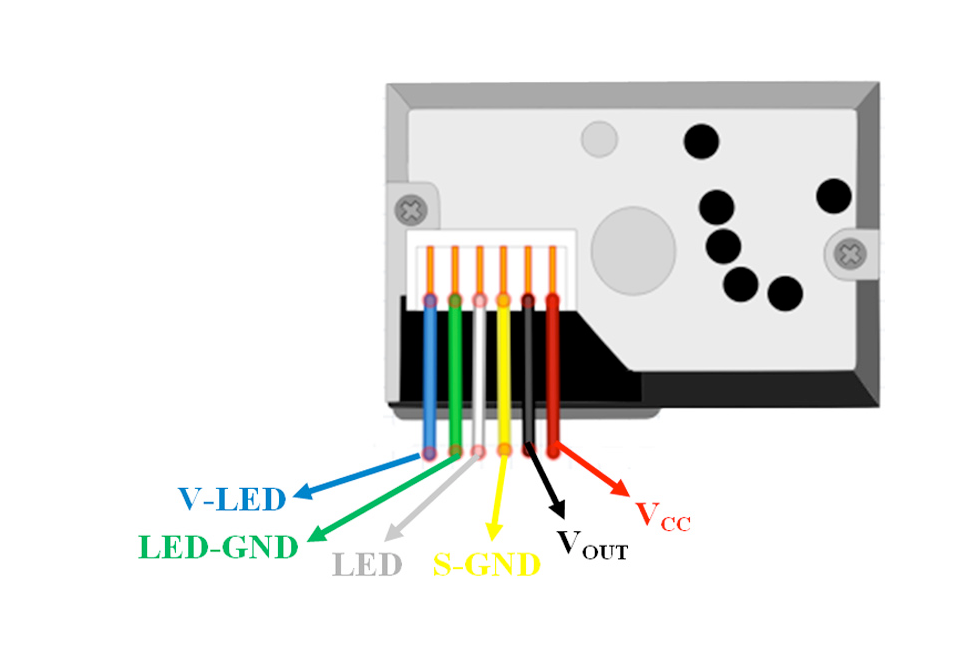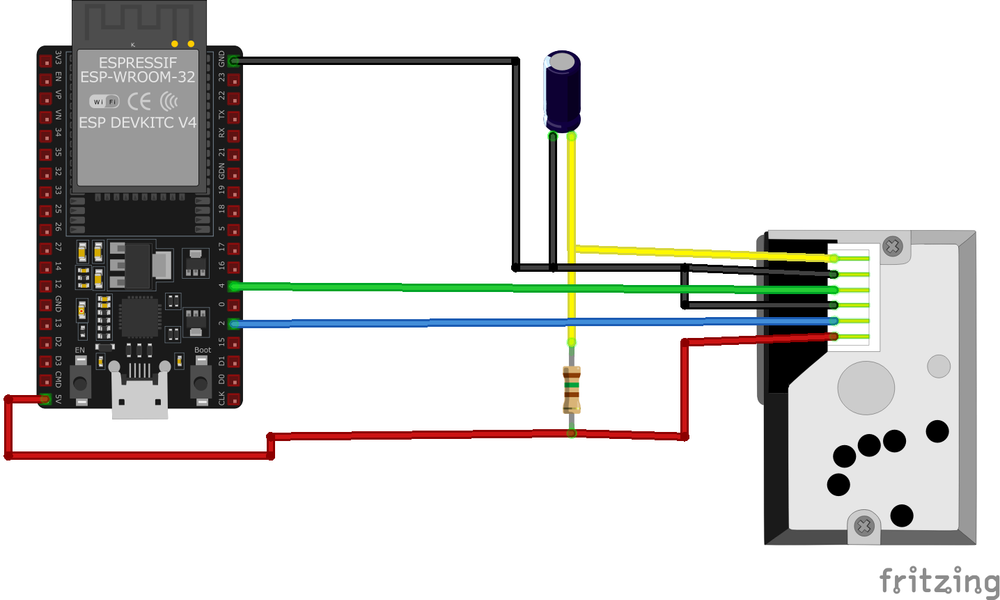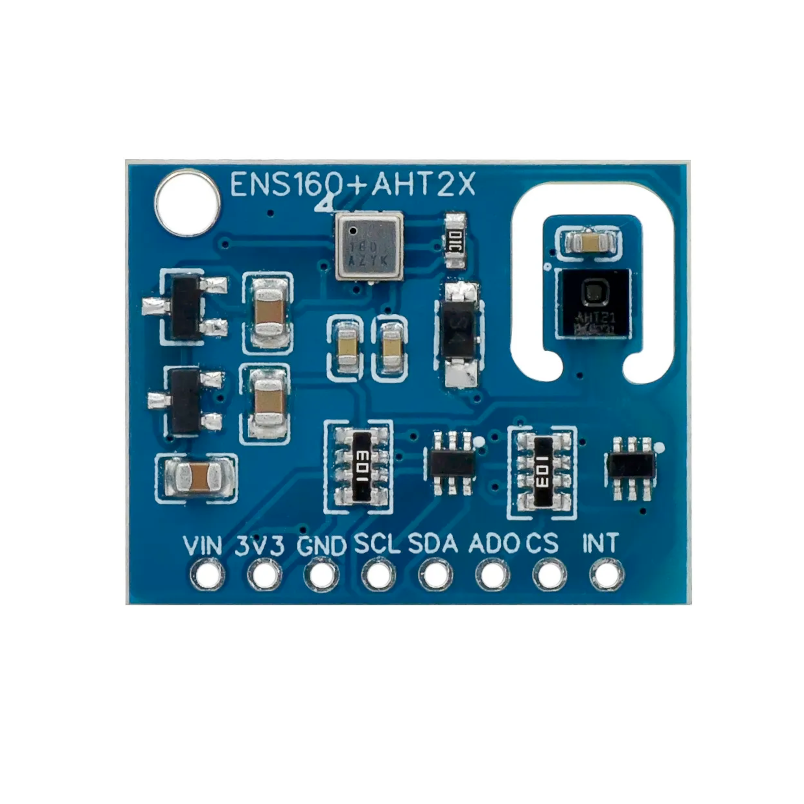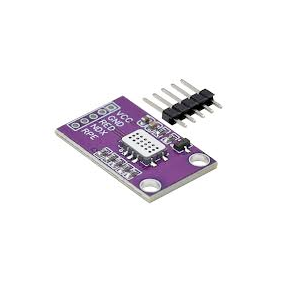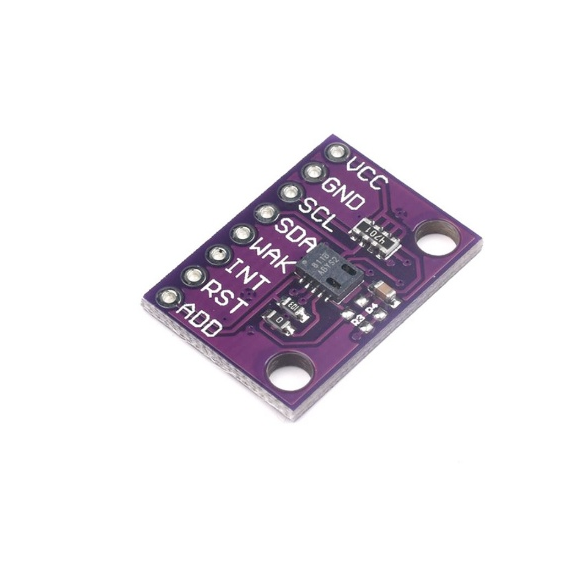ESP32 Sharp GP2Y1010AU0F Optical Dust Sensor
Overview
The Sharp GP2Y1010AU0F is an optical dust sensor designed for air quality monitoring. It detects fine particles like cigarette smoke by measuring the reflected light from an internal infrared LED. The sensor provides an analog voltage output proportional to the dust concentration, making it suitable for integration into air purifiers and HVAC systems.
About Sharp GP2Y1010AU0F Optical Dust Sensor
The Sharp GP2Y1010AU0F is an optical air quality sensor designed to detect fine dust particles in the air. Using an infrared LED and a phototransistor, it measures light reflection from airborne particles, making it ideal for air purifiers and environmental monitoring.
⚡ Key Features
- Infrared-Based Detection – Uses an IR LED and phototransistor to detect fine dust.
- Analog Voltage Output – Provides readings proportional to dust density.
- High Sensitivity – Capable of detecting very fine particles, including cigarette smoke.
- Compact & Low Power – Easily integrates into microcontroller-based air quality systems.
The GP2Y1010AU0F is widely used in air purifiers, HVAC systems, and environmental monitoring for real-time air quality detection. 🚀
The GP2Y1010AU0F operates with a low current consumption of up to 20 mA and a typical operating voltage range of 4.5V to 5.5V. It can detect dust particles by measuring the photometry of a single pulse, enabling it to distinguish between smoke and house dust. The sensor’s compact dimensions (46.0 x 30.0 x 17.6 mm) make it easy to integrate into various applications, including air purifiers, HVAC systems, and other air quality monitoring devices.
Where to Buy



Prices are subject to change. We earn from qualifying purchases as an Amazon Associate.
Technical Specifications
Pinout Configuration
The VCC pin is used to supply power to the sensor, and it typically requires 3.3V or 5V (refer to the datasheet for specific voltage requirements). The GND pin is the ground connection and must be connected to the ground of your ESP32.
The GP2Y1010AU0F pinout is as follows:
- Pin 1 (V-LED): LED power supply (typically connected to 5V through a 150Ω resistor).
- Pin 2 (LED-GND): LED ground.
- Pin 3 (LED): LED control input (connect to a digital output pin on the microcontroller).
- Pin 4 (S-GND): Signal ground.
- Pin 5 (Vo): Analog voltage output proportional to dust density (connect to an analog input pin on the microcontroller).
- Pin 6 (Vcc): Power supply (typically 5V).
Wiring with ESP32
Vcc to the 5V power supply, LED-GND and S-GND to ground, Vo to an analog input pin (e.g., A0), and LED to a digital output pin (e.g., D9). Additionally, connect V-LED to 5V through a 150Ω resistor. This setup allows the microcontroller to control the sensor's LED and read the analog voltage output corresponding to dust density.Troubleshooting Guide
Common Issues
0️⃣ Consistent Zero or Negative Dust Density Readings
Issue: The GP2Y1010AU0F sensor outputs constant zero or negative dust density values, indicating potential issues with sensor readings.
Possible causes include incorrect wiring, improper LED control timing, or incorrect voltage reference in calculations.
Solution: Ensure that the sensor's LED control pin is correctly connected to a digital output pin on the microcontroller and that the timing sequence for LED pulsing aligns with the sensor's specifications. Verify that the analog output (Vo) is connected to an appropriate analog input pin. Additionally, confirm that the voltage reference used in calculations matches the actual operating voltage of the sensor (typically 5V).
🔄 Inconsistent or Fluctuating Readings
Issue: The sensor provides inconsistent or fluctuating dust density readings, making it difficult to obtain accurate measurements.
Possible causes include unstable power supply, external light interference, or improper sensor placement.
Solution: Use a regulated power supply to ensure stable voltage levels. Shield the sensor from external light sources, as ambient light can affect the internal photodetector. Position the sensor in a location with consistent airflow and minimal vibration to improve measurement stability.
🚫 Sensor Not Responding to Dust Presence
Issue: The GP2Y1010AU0F sensor does not show any change in readings when exposed to dust, indicating a lack of responsiveness.
Possible causes include a malfunctioning internal LED, blocked optical path, or incorrect sensor orientation.
Solution: Inspect the sensor for any obstructions in the optical path and clean if necessary. Ensure that the sensor is oriented correctly, with the dust entry hole unobstructed. If the internal LED is suspected to be faulty, consider replacing the sensor.
⚡ Incorrect Voltage Calculations Leading to Erroneous Readings
Issue: Miscalculations in converting analog readings to voltage result in incorrect dust density values.
Possible causes include using an incorrect reference voltage in calculations or not accounting for the sensor's sensitivity factor.
Solution: Ensure that the analog-to-digital conversion uses the correct reference voltage, matching the sensor's operating voltage (typically 5V). Apply the appropriate sensitivity factor as specified in the sensor's datasheet to convert voltage readings to dust density accurately.
Debugging Tips
🔍 Serial Monitor
Use the Serial Monitor to check for error messages and verify the sensor's output. Add debug prints in your code to track the sensor's state.
⚡ Voltage Checks
Use a multimeter to verify voltage levels and check for continuity in your connections. Ensure the power supply is stable and within the sensor's requirements.
Additional Resources
Code Examples
Arduino Example
#include <GP2YDustSensor.h>
const uint8_t SHARP_LED_PIN = 14; // Sharp Dust/particle sensor Led Pin
const uint8_t SHARP_VO_PIN = A0; // Sharp Dust/particle analog out pin used for reading
GP2YDustSensor dustSensor(GP2YDustSensorType::GP2Y1014AU0F, SHARP_LED_PIN, SHARP_VO_PIN);
void setup() {
Serial.begin(9600);
//dustSensor.setBaseline(0.4); // set no dust voltage according to your own experiments
//dustSensor.setCalibrationFactor(1.1); // calibrate against precision instrument
dustSensor.begin();
}
void loop() {
Serial.print("Dust density: ");
Serial.print(dustSensor.getDustDensity());
Serial.print(" ug/m3; Running average: ");
Serial.print(dustSensor.getRunningAverage());
Serial.println(" ug/m3");
delay(1000);
}This Arduino sketch interfaces with the GP2Y1014AU0F dust sensor to measure dust density in the air. The sensor is controlled using the GP2YDustSensor library.
Library Requirement #
To use this code, you need to install the GP2YDustSensor library.
Installation in Arduino IDE #
- Open Arduino IDE.
- Go to Sketch → Include Library → Manage Libraries.
- In the search bar, type "GP2YDustSensor".
- Click Install on the library by Lucian Sabo.
Alternatively, you can manually download it from the GitHub repository"
🔗 GP2YDustSensor Library
ESP-IDF Example
#include <stdio.h>
#include <stdlib.h>
#include "freertos/FreeRTOS.h"
#include "freertos/task.h"
#include "driver/adc.h"
#include "esp_adc_cal.h"
#include "driver/gpio.h"
#include "esp_system.h"
#include "esp_log.h"
#include "rom/ets_sys.h" // For microsecond delays
#define LED_PIN 2 // Change to the GPIO pin connected to the LED
#define ADC_CHANNEL ADC1_CHANNEL_6 // GPIO34 (ADC1_CH6)
#define DEFAULT_VREF 1100 // Default ADC reference voltage in mV
#define NO_OF_SAMPLES 64 // Number of ADC samples for averaging
static esp_adc_cal_characteristics_t adc_chars = NULL;
static const char TAG = "ESP32_ADC_Task";
// Function to initialize ADC
void init_adc() {
ESP_ERROR_CHECK(adc1_config_width(ADC_WIDTH_BIT_12));
ESP_ERROR_CHECK(adc1_config_channel_atten(ADC_CHANNEL, ADC_ATTEN_DB_0));
adc_chars = calloc(1, sizeof(esp_adc_cal_characteristics_t));
if (adc_chars == NULL) {
ESP_LOGE(TAG, "Failed to allocate memory for ADC characteristics");
return;
}
// Check and calibrate ADC using eFuse Vref
if (esp_adc_cal_check_efuse(ESP_ADC_CAL_VAL_EFUSE_VREF) == ESP_OK) {
esp_adc_cal_characterize(ADC_UNIT_1, ADC_ATTEN_DB_0, ADC_WIDTH_BIT_12, DEFAULT_VREF, adc_chars);
} else {
ESP_LOGW(TAG, "eFuse Vref not available, using default Vref");
esp_adc_cal_characterize(ADC_UNIT_1, ADC_ATTEN_DB_0, ADC_WIDTH_BIT_12, DEFAULT_VREF, adc_chars);
}
}
// Function to read ADC value
uint32_t read_adc_value() {
uint32_t adc_reading = 0;
for (int i = 0; i < NO_OF_SAMPLES; i++) {
adc_reading += adc1_get_raw(ADC_CHANNEL);
}
adc_reading /= NO_OF_SAMPLES; // Average
// Convert raw ADC value to voltage (mV)
uint32_t voltage = esp_adc_cal_raw_to_voltage(adc_reading, adc_chars);
ESP_LOGI(TAG, "Raw ADC: %lu, Voltage: %lu mV", (unsigned long)adc_reading, (unsigned long)voltage);
return voltage;
}
// Function to initialize LED
void init_led() {
gpio_reset_pin(LED_PIN);
gpio_set_direction(LED_PIN, GPIO_MODE_OUTPUT);
}
// Task to blink LED with precise timing
void led_task(void pvParameters) {
while (1) {
gpio_set_level(LED_PIN, 1);
ets_delay_us(280); // 280µs delay (sub-millisecond precision)
gpio_set_level(LED_PIN, 0);
vTaskDelay(pdMS_TO_TICKS(1000)); // Delay for 1 second
}
}
// Task to read ADC values
void adc_task(void pvParameters) {
while (1) {
read_adc_value();
vTaskDelay(pdMS_TO_TICKS(2000)); // Read ADC every 2 seconds
}
}
// Main function
void app_main() {
init_led();
init_adc();
xTaskCreate(led_task, "LED Task", 2048, NULL, 2, NULL);
xTaskCreate(adc_task, "ADC Task", 2048, NULL, 2, NULL);
}This ESP-IDF program is designed for the ESP32 to interface with an analog sensor (such as the GP2Y1010AU0F dust sensor) while managing an LED pulse and processing ADC readings.
Functionality Overview #
1. LED Control (GPIO2) #
- The LED is pulsed for 280µs using
ets_delay_us(280), ensuring precise timing. - This pulse is required for sensors like the GP2Y1010AU0F, which measure dust concentration by detecting reflected light.
2. ADC Sampling (GPIO34 - ADC1_CH6) #
- The ESP32 reads analog voltage from the sensor using ADC1_CHANNEL_6.
- Multiple samples (64) are taken and averaged for better accuracy.
- The ADC converts the sensor's output into a voltage value.
3. ADC Calibration #
- The ESP32 checks for eFuse-stored reference voltage for better accuracy.
- If no eFuse calibration data is found, a default 1100mV reference is used.
4. Multi-tasking with FreeRTOS #
- LED Task: Pulses the LED every second to trigger the sensor reading.
- ADC Task: Reads sensor data and prints the measured voltage every 2 seconds.
Expected Output #
The console logs raw ADC values and converted voltages.
The LED blinks briefly every second.
If connected to a dust sensor, the ESP32 can estimate air quality by processing voltage changes.
ESPHome Example
sensor:
- platform: adc
pin: GPIO36
name: "Dust Density"
update_interval: 1s
filters:
- calibrate_linear:
- 0.0 -> 0.0
- 2.5 -> 0.5 # Adjust these values based on sensor calibration
unit_of_measurement: "µg/m³"
gpio:
- platform: output
pin: GPIO4
id: led_control
interval:
- interval: 1s
then:
- output.turn_on: led_control
- delay: 0.28ms
- output.turn_off: led_controlPlatformIO Example
platformio.ini
[env:esp32dev]
platform = espressif32
board = esp32dev
framework = arduino
monitor_speed = 115200PlatformIO Example Code
#include <Arduino.h>
const int measurePin = 36; // Analog input pin connected to Vo
const int ledPin = 4; // Digital output pin connected to LED control
void setup() {
Serial.begin(115200);
pinMode(ledPin, OUTPUT);
}
void loop() {
digitalWrite(ledPin, HIGH);
delayMicroseconds(280); // LED on for 280µs
int sensorValue = analogRead(measurePin);
digitalWrite(ledPin, LOW);
// Convert sensor value to voltage (assuming 3.3V ADC reference)
float voltage = sensorValue * (3.3 / 4095.0);
// Convert voltage to dust density (example calibration formula)
float dustDensity = (voltage - 0.4) / 0.05; // µg/m³
Serial.print("Dust Density: ");
Serial.print(dustDensity);
Serial.println(" µg/m³");
delay(1000); // Wait 1 second before the next reading
}MicroPython Example
from machine import Pin, ADC
import time
# Pin definitions
led_pin = Pin(4, Pin.OUT) # LED control pin
adc = ADC(Pin(36)) # Analog input pin
adc.width(ADC.WIDTH_12BIT) # 12-bit ADC resolution
adc.atten(ADC.ATTN_11DB) # Full-scale voltage (up to 3.3V)
def read_dust_density():
led_pin.value(1)
time.sleep_us(280) # LED pulse width
raw_value = adc.read()
led_pin.value(0)
# Convert raw ADC value to voltage (assuming 3.3V reference)
voltage = raw_value * (3.3 / 4095.0)
# Convert voltage to dust density (calibration formula)
dust_density = (voltage - 0.4) / 0.05 # µg/m³
return dust_density
while True:
dust_density = read_dust_density()
print(f"Dust Density: {dust_density:.2f} µg/m³")
time.sleep(1)read_dust_density() function pulses the LED for 280 microseconds, reads the ADC value, and converts it to voltage. The voltage is then translated into dust density using a calibration formula. The main loop retrieves and prints the dust density every second.Conclusion
The ESP32 Sharp GP2Y1010AU0F Optical Dust Sensor is a powerful Air Quality sensor that offers excellent performance and reliability. With support for multiple development platforms including Arduino, ESP-IDF, ESPHome, PlatformIO, and MicroPython, it's a versatile choice for your IoT projects.
For optimal performance, ensure proper wiring and follow the recommended configuration for your chosen development platform.
Always verify power supply requirements and pin connections before powering up your project to avoid potential damage.


